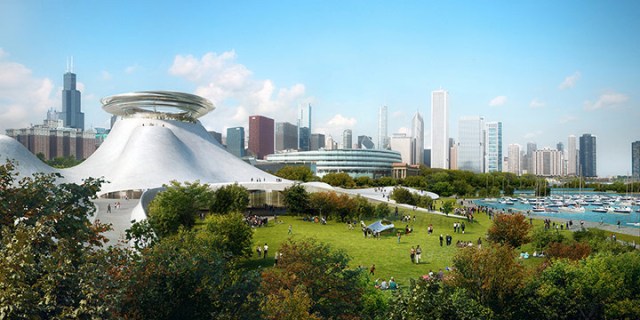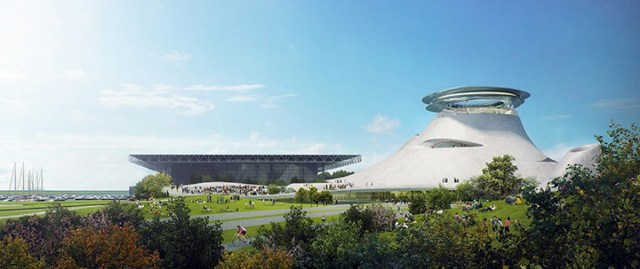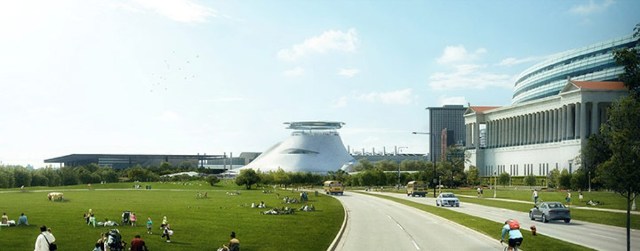The Empire Strikes: A First Look At The Lucas Museum
By Chuck Sudo in News on Nov 4, 2014 3:30PM

Rising up from the land and crescendoing to a “floating” disc, the tallest points of the Lucas Museum will feature an observation deck, providing visitors with stunning views ofboth Chicago and Lake Michigan. (Image courtesy Lucas Museum of Narrative Art)
Depending on your point of view, architect Ma Yansong’s vision for the Lucas Museum of Narrative Art is either a breathtaking design that will perfectly complement Chicago’s rich architectural history or it’s an invasive lakefront species akin to Asian carp.
Maybe it’s a little of both.
The Lucas Museum revealed renderings of Yansong’s design for the museum Monday (with an optional stormtrooper training center for Jango Fett clones) and it’s both breathtaking yet seemingly out of place nestled between McCormick Place and Soldier Field. You can see why Lucas chose avant-garde architect Ma to build the museum that will house Lucas’ impressive collection of film, digital and narrative art.

Earth, stone and sky merge seamlessly in the innovative design of the Lucas Museum. (Image credit: Lucas Museum of Narrative Art)
Ma told the Sun-Times his design for the museum represents “a new type of architecture” intended to be part of the existing landscape. The white, flowing structure—which Ma said would be built from stone or concrete—is crowned with a ring-shaped “observation deck” providing guests with exquisite views of the downtown skyline and lakefront. Ma’s design reminds me in some ways of Jeanne Gang’s Aqua Tower, with its similar flowing, liquid design. (Gang’s firm, Studio Gang Architects, will build a pedestrian bridge connecting the museum to the lakefront and tackle the landscaping around the museum.)
Inside is what Ma described as a “very large dome” that can serve as a concert hall, while a “very large portion” of the museum would be set aside for education, archival projects and art storage. Ma told Tribune architecture critic Blair Kamin he hopes the Lucas Museum has an impact on the city similar to Millennium Park. “Our site deserves something like that.”

Situated between McCormick Place and Soldier Field, the Lucas Museum of Narrative Art will expand public access to green space on Monroe Harbor. (Image courtesy Lucas Museum of Narrative Art)
But, as Kamin notes, the mountainous design of the Lucas Museum stands out like a sore thumb among the flat Midwestern prairie of Chicago’s lakefront. Preservationists who are already complaining about the 17 acres of lakefront property already earmarked for the Lucas Museum have a legitimate beef that, if this design stays on track, it could block views of the shoreline; Kamin writes, almost with relish, this will add fuel to Friends of the Parks’ opposition to the project. Friends of the Parks has threatened to block the project in court.
The most surprising aspect of the design is it has the backing of Lucas, who previously embraced the idea of a Spanish Revival design when it looked as though the Lucas Museum would call San Francisco home.
It’s a beautiful structure. I’m just not sure it fits on the lakefront. Fitting, then, that the Emanuel administration offered land for the Lucas Museum between two other ballyhooed projects in McCormick Place and Soldier Field, the latter which still looks out of place squeezed between historic colonnades like a futuristic bedpan.